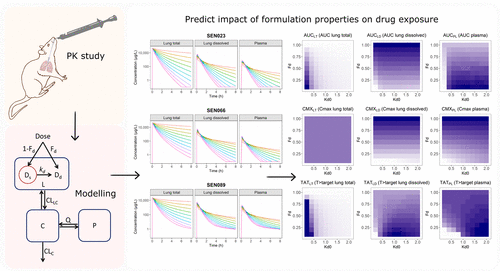Our official English website, www.x-mol.net, welcomes your
feedback! (Note: you will need to create a separate account there.)
Model-Informed Drug Discovery and Development in Pulmonary Delivery: Biopharmaceutical Pharmacometric Modeling for Formulation Evaluation of Pulmonary Suspensions
ACS Omega ( IF 3.7 ) Pub Date : 2020-09-22 , DOI: 10.1021/acsomega.0c03004 Tomás Sou 1, 2 , Fadi Soukarieh 3, 4 , Paul Williams 3, 4 , Michael J. Stocks 4, 5 , Miguel Cámara 3, 4 , Christel A. S. Bergström 6, 7
ACS Omega ( IF 3.7 ) Pub Date : 2020-09-22 , DOI: 10.1021/acsomega.0c03004 Tomás Sou 1, 2 , Fadi Soukarieh 3, 4 , Paul Williams 3, 4 , Michael J. Stocks 4, 5 , Miguel Cámara 3, 4 , Christel A. S. Bergström 6, 7
Affiliation

|
For respiratory conditions, targeted drug delivery to the lungs could produce higher local concentrations with reduced risk of adverse events compared to systemic administration. Despite the increasing interest in pulmonary delivery, the pharmacokinetics (PK) of drugs following pulmonary administration remains to be elucidated. In this context, the application of modeling and simulation methodologies to characterize PK properties of compounds following pulmonary administration remains a scarcity. Pseudomonas aeruginosa (PA) lung infections are resistant to many of the current antibiotic therapies. Targeted treatments for pulmonary delivery could be particularly beneficial for these local conditions. In this study, we report the application of biopharmaceutical pharmacometrics (BPMX) for the analysis of PK data from three investigational antimicrobial agents following pulmonary administration of a suspension formulation. The observed drug concentration–time profiles in lungs and plasma of the compound series were combined for simultaneous analysis and modeling. The developed model describes the PK data, taking into account formulation properties, and provides a mechanism to predict dissolved drug concentrations in the lungs available for activity. The model was then used to evaluate formulation effects and the impact of variability on total and dissolved drug concentrations in lungs and plasma. The predictions suggest that these therapies for lung delivery should ideally be delivered in a sustained release formulation with high solubility for maximum local exposure in lungs for efficacy, with rapid systemic clearance in plasma for reduced risk of unwanted systemic adverse effects. This work shows the potential benefits of BPMX and the role it can play to support drug discovery and development in pulmonary delivery.
中文翻译:

肺部给药中模型知情的药物的发现和开发:肺悬浮液制剂评价的生物制药药理学模型
对于呼吸系统疾病,与全身给药相比,靶向药物向肺部给药可产生更高的局部浓度,从而减少不良事件的发生。尽管对肺部递送的兴趣日益增加,但仍需阐明在肺部给药后药物的药代动力学(PK)。在这种情况下,仍然缺乏在建模和模拟方法上表征肺部给药后化合物的PK特性的应用。铜绿假单胞菌(PA)肺部感染对许多当前的抗生素疗法有抵抗力。针对这些局部情况,针对肺部递送的靶向治疗可能特别有益。在这项研究中,我们报告了肺部给药悬浮液制剂后,生物药物药理学(BPMX)在分析三种研究性抗菌药物的PK数据中的应用。将化合物系列在肺和血浆中观察到的药物浓度-时间曲线结合起来,以便同时进行分析和建模。所开发的模型在考虑配方特性的情况下描述了PK数据,并提供了预测可用于活动的肺中溶解药物浓度的机制。然后将该模型用于评估配方效果以及变异性对肺和血浆中总和溶解药物浓度的影响。这些预测表明,理想的是,这些用于肺部递送的疗法应以具有高溶解度的缓释制剂进行递送,以实现最大的肺部局部暴露以达到疗效,并在血浆中快速全身清除以降低不良的系统性不良反应的风险。这项工作显示了BPMX的潜在好处,以及它在支持肺部给药中的药物发现和开发中所起的作用。具有快速的血浆全身清除率,可降低不良的全身性不良反应的风险。这项工作显示了BPMX的潜在好处,以及它在支持肺部给药中的药物发现和开发中所起的作用。具有快速的血浆全身清除率,可降低不良的全身性不良反应的风险。这项工作显示了BPMX的潜在好处,以及它在支持肺部给药中的药物发现和开发中所起的作用。
更新日期:2020-10-13
中文翻译:

肺部给药中模型知情的药物的发现和开发:肺悬浮液制剂评价的生物制药药理学模型
对于呼吸系统疾病,与全身给药相比,靶向药物向肺部给药可产生更高的局部浓度,从而减少不良事件的发生。尽管对肺部递送的兴趣日益增加,但仍需阐明在肺部给药后药物的药代动力学(PK)。在这种情况下,仍然缺乏在建模和模拟方法上表征肺部给药后化合物的PK特性的应用。铜绿假单胞菌(PA)肺部感染对许多当前的抗生素疗法有抵抗力。针对这些局部情况,针对肺部递送的靶向治疗可能特别有益。在这项研究中,我们报告了肺部给药悬浮液制剂后,生物药物药理学(BPMX)在分析三种研究性抗菌药物的PK数据中的应用。将化合物系列在肺和血浆中观察到的药物浓度-时间曲线结合起来,以便同时进行分析和建模。所开发的模型在考虑配方特性的情况下描述了PK数据,并提供了预测可用于活动的肺中溶解药物浓度的机制。然后将该模型用于评估配方效果以及变异性对肺和血浆中总和溶解药物浓度的影响。这些预测表明,理想的是,这些用于肺部递送的疗法应以具有高溶解度的缓释制剂进行递送,以实现最大的肺部局部暴露以达到疗效,并在血浆中快速全身清除以降低不良的系统性不良反应的风险。这项工作显示了BPMX的潜在好处,以及它在支持肺部给药中的药物发现和开发中所起的作用。具有快速的血浆全身清除率,可降低不良的全身性不良反应的风险。这项工作显示了BPMX的潜在好处,以及它在支持肺部给药中的药物发现和开发中所起的作用。具有快速的血浆全身清除率,可降低不良的全身性不良反应的风险。这项工作显示了BPMX的潜在好处,以及它在支持肺部给药中的药物发现和开发中所起的作用。










































 京公网安备 11010802027423号
京公网安备 11010802027423号